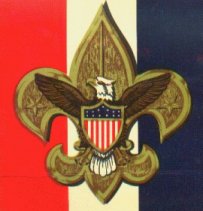|
Character Development
Character encompasses a youth's personal qualities, values, and outlook. Scouting strives to help a youth grow in the following ways:
He or she...
- becomes confident but is not conceited.
- is honest.
- has a personal appearance that shows self respect.
- develops special skills and interests.
- can be responsible for self care, especially in emergencies.
- can be counted upon to do his or her best, even in difficult situations.
- practices personal religious beliefs.
- respects other people regardless of their differences.
|
|
|
Citizenship Training
The Scouting program allows youth to practice good citizenship by living and working among others in a troop with rules based on the common good. Each Scout is further encouraged to do the following:
- Learn about and take pride in national heritage.
- Develop an understanding of social, economic, and governmental systems.
- Be of service to others.
- Have knowledge of and respect for other cultures and social groups.
- Be aware of community organizations and their functions.
- Appreciate the environment and seek to protect it.
|
|
|
Mental and Physical Fitness
People get the most out of life when they are mentally and physically fit. Scouting motivates each Scout to work toward these goals:
- Improve general physical condition through exercise and participation in vigorous activities that might include outdoor adventures and sports.
- Eat properly, get enough sleep, and follow other habits for good health.
- Keep weight within a healthy range.
- Reject experimenting with tobacco, alcohol, and illegal drugs, or with other activities that can be harmful.
- Strive to be mentally alert.
- Use good judgment and make sound decisions.
- Train to be resourceful in solving problems.
|
|
|
The Methods of Scouting
The Boy Scouts of America uses eight fundamental methods to meet youths' hope for fun and adventure, and to achieve Scouting's aims of encouraging character development, citizenship, and mental and physical fitness.
|
|
Method 1 - The Ideals:
The ideals of Scouts BSA are spelled out in the Scout Oath, Scout Law, Scout motto, and Scout slogan. Scouts and adult leaders incorporating these ideals into their daily lives are said to have Scout Spirit.
|
|
Method 2 - The Patrol Method:
Within the larger community of the troop, the patrol is a Scout's "family circle." Each patrol helps its members develop a sense of pride and identity. The boys themselves elect their patrol leader, divide up the jobs to be done, and share in the satisfaction of accepting and fulfilling group responsibilities.
|
|
|
Method 3 -The Outdoors:
Youth join Scouting for the challenge, the excitement, and the fun. Much of Scouting is designed to take place outdoors in settings where Scouts can find real adventure.
|
|
Method 4 - Advancement:
Scouts BSA believes that youth should receive recognition for their achievements. The requirements for the ranks of Tenderfoot through First Class prepare Scouts to take full advantage of all that Scouting has to offer. Earning merit badges allows them to explore many fields, helps them round out their skills, and perhaps introduces them to subjects that will become lifelong interests and rewarding careers. In addition, advancement sets a pattern of setting positive goals and reaching them through life. Star,
Life, and Eagle requirements focus on service to others and developing leadership skills.
|
|
Method 5 - Association with Adults:
Scouts learn a great deal by watching how adults conduct themselves. Scout leaders are positive role models for the members of the troop, and take a personal interest in the development of each boy.
|
|
Method 6 -Personal Growth:
Scout-age youth are experiencing dramatic physical and emotional growth. Scouting offers them opportunities to channel much of that change into productive endeavors and to find the answers they are seeking for many of their questions. Through service projects and Good Turns, Scouts can discover their place in their community. The troop itself provides each Scout with an arena in which to explore, to try out new ideas, and sometimes simply to embark on adventures with no design other than having a good time with good people.
|
|
Method 7 - Leadership Development:
Leadership is a skill that can be learned only by doing it. Every Scout in a patrol and troop will find that they are filling leadership positions of increasing responsibility. Through leadership experiences, boys learn planning, organization, and decision making.
|
|




